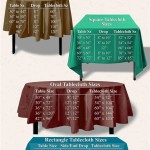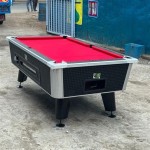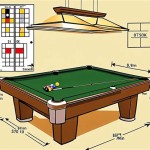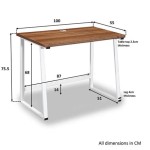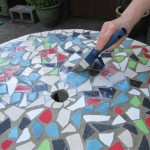Your article should include sections on design considerations, material selection, and step-by-step build instructions, as well as a section on extension mechanism options. It should also include a section on finishing.
Expanding Round Dining Table Plans: A Comprehensive Guide
The expanding round dining table presents a versatile solution for homeowners seeking adaptable furniture. Its circular form promotes conversation and intimacy, while its expandable nature allows for accommodating larger gatherings when necessary. This article provides a comprehensive guide to planning and constructing an expanding round dining table, covering design considerations, material selection, extension mechanism options, step-by-step build instructions, and finishing techniques.
Design Considerations for Expanding Round Dining Tables
Effective design is crucial for a functional and aesthetically pleasing expanding round dining table. Initial planning should consider the table's intended use, available space, and desired aesthetic. The diameter of the round table in its collapsed state should comfortably accommodate the usual number of diners. Determining the maximum number of diners and the desired space per person will dictate the overall dimensions of the expanded table. A comfortable allowance is approximately 24 inches per person. Thus, a table expanding to seat eight people would require an expanded circumference of around 192 inches, factoring in the support structure and edge details. Beyond the practical dimensions, the table's style should complement the existing décor. Considerations include the leg design (tapered, turned, or pedestal), edge profile (rounded, beveled, or square), and overall form, which can range from traditional to contemporary. The apron, the connecting piece between the tabletop and the legs, also contributes to the overall style and structural integrity of the table. The design should also anticipate the aesthetic of the expansion leaves, ensuring a seamless transition when the table is expanded. The storage location for the leaves when not in use should also be considered during the design phase. Will they be stored separately, or will a self-storing mechanism be incorporated into the table?
The expansion mechanism is a critical design consideration. Different mechanisms impact the table's appearance, ease of use, and required construction techniques. The most common mechanisms involve leaves inserted into a gap created by separating the two halves of the round tabletop. The method of separating the two halves can vary, influencing the overall design. A center-split mechanism involves separating the two halves along a central seam. A perimeter-split mechanism involves separating the two halves along the circumference of the circle, creating a larger gap for leaf insertion. The choice between these mechanisms affects the undercarriage structure and the means of supporting the leaves. The height and angle of the table legs and apron must be considered when the table is expanded. The undercarriage structure needs to be robust enough to support the weight of the expanded tabletop and any weight placed upon it during use. The choice of the mechanism should balance aesthetics, functionality, and the builder's skill level.
Material Selection for Durability and Aesthetics
The choice of materials significantly impacts the durability, appearance, and cost of the expanding round dining table. Hardwoods are generally preferred for their strength, stability, and aesthetic appeal. Options include maple, oak, cherry, walnut, and ash, each with its unique grain pattern, color, and hardness. Maple is a close-grained hardwood known for its durability and light color, making it suitable for painted or stained finishes. Oak is a classic choice, known for its prominent grain pattern and robustness. Cherry offers a rich, reddish-brown hue and polishes beautifully. Walnut is a premium hardwood with a dark, elegant color and distinctive grain. Ash is a strong and flexible hardwood with a light, creamy color and can be stained to mimic other wood species. The choice of hardwood depends on the desired aesthetic and budget. For a painted finish, a less expensive hardwood like poplar might be suitable, although it lacks the inherent beauty of premium hardwoods. Plywood and MDF (Medium-Density Fiberboard) are commonly used for internal structural components, such as the support frame for the expansion leaves. These materials offer stability and can be easily shaped. However, they are generally not used for visible surfaces due to their less appealing appearance. The thickness of the material should be carefully considered based on the size and intended use of the table. A thicker tabletop and legs will provide greater stability and prevent sagging or warping. The hardware used for the expansion mechanism should be durable and corrosion-resistant. Options include steel, brass, and aluminum, depending on the desired aesthetic and budget. Considerations should be given to sourcing sustainable and responsibly harvested wood. This ensures environmental responsibility and supports ethical forestry practices.
Extension Mechanism Options: Functionality and Ease of Use
Several extension mechanism options are available for expanding round dining tables, each with its advantages and disadvantages. The choice of mechanism impacts the table's functionality, appearance, and construction complexity. The most common mechanism involves leaves inserted into a gap created by separating the two halves of the round tabletop. This type of mechanism requires a robust support structure to maintain stability when the table is expanded. The simplest method involves a center-split mechanism, where the two halves of the tabletop separate along a central seam. This mechanism is relatively easy to construct but may require additional supports to prevent sagging. Another approach employs a perimeter-split mechanism, where the two halves of the tabletop separate along the circumference of the circle. This mechanism creates a larger gap for leaf insertion but requires a more complex undercarriage structure to maintain stability. Gear mechanisms can be incorporated to provide a smooth and synchronized separation of the tabletop halves. These mechanisms typically involve a series of gears and tracks that ensure the two halves move evenly. While more complex to install, gear mechanisms offer a more refined and user-friendly experience. Self-storing leaves are a convenient feature that allows the leaves to be stored within the table when not in use. This eliminates the need for separate storage and makes it easier to expand the table quickly. Self-storing leaves typically involve a hinged mechanism that allows the leaves to fold and tuck away under the tabletop. The mechanics of the chosen extension must be thoroughly studied before construction to ensure smooth operation and stability. Consideration must be given to the smoothness of opening and closing the table. This will involve the type of hardware used, the precision of cuts, and the quality of assembly.
Step-by-Step Build Instructions: A Practical Guide
Constructing an expanding round dining table requires careful planning, precise measurements, and attention to detail. A detailed set of plans is essential before beginning the project. The plans should include dimensions, material lists, and detailed instructions for each step of the construction process. The first step involves cutting the tabletop components. Two semi-circular pieces will form the main tabletop. These can be cut from solid wood or plywood, depending on the desired aesthetic and budget. Use a jigsaw or router with a circle-cutting jig to ensure accurate and uniform cuts. The edges of the semi-circular pieces should be smooth and free of splinters. Next, construct the apron, the component that connects the tabletop to the legs. The apron can be made from solid wood or plywood and should be cut to the appropriate dimensions. The apron should be securely attached to the underside of the tabletop using screws and wood glue. The legs can be purchased pre-made or crafted from solid wood. Tapered legs, turned legs, or pedestal bases are common options. The legs should be securely attached to the apron using screws, bolts, and wood glue. The expansion mechanism should be installed according to the manufacturer's instructions. Ensure the mechanism is properly aligned and operates smoothly. Construct the leaves, which will be inserted into the gap created by separating the tabletop halves. The leaves should be made from the same material as the tabletop and should be precisely dimensioned to fit snugly into the gap. Hinges and latches can be added to the leaves to facilitate their insertion and removal. Sand all surfaces of the table to create a smooth and even finish. Start with a coarse-grit sandpaper and gradually progress to a finer grit. Pay particular attention to the edges and corners, ensuring they are rounded and free of sharp edges. Test the expansion mechanism to ensure smooth operation. Adjust the hinges, latches, and tracks as needed. Constructing an expanding round dining table requires patience, precision, and attention to detail. Following these steps will help ensure a successful outcome.
Finishing: Enhancing Beauty and Protection
Finishing is a critical step in the construction of an expanding round dining table, enhancing its beauty and protecting it from wear and tear. The choice of finish depends on the type of wood used, the desired aesthetic, and the level of protection required. Sanding is the first step in the finishing process. Ensure all surfaces are smooth and free of imperfections. Start with a coarse-grit sandpaper and gradually progress to a finer grit. Remove all sanding dust with a tack cloth or vacuum cleaner. Staining can be used to enhance the color and grain of the wood. Choose a stain that complements the wood species and the overall décor. Apply the stain evenly using a brush, rag, or sprayer. Allow the stain to dry completely before applying the next coat. Sealing creates a protective barrier against moisture, scratches, and stains. Options include polyurethane, lacquer, varnish, and shellac. Polyurethane is a durable and water-resistant finish that is suitable for high-traffic areas. Lacquer is a fast-drying finish that provides a smooth and glossy surface. Varnish is a traditional finish that offers good protection and a warm, amber hue. Shellac is a natural finish that is easy to apply and repair. Apply the sealant evenly using a brush, rag, or sprayer. Allow the sealant to dry completely before applying the next coat. Multiple coats of sealant may be necessary to achieve the desired level of protection. Between coats, lightly sand the surface with fine-grit sandpaper to remove any imperfections. A topcoat provides additional protection and enhances the appearance of the finish. Options include wax, oil, and varnish. Wax provides a soft, lustrous sheen and is easy to apply and maintain. Oil penetrates the wood and provides a natural look and feel. Varnish offers excellent protection and a durable finish. Apply the topcoat evenly using a brush, rag, or sprayer. Buff the surface with a soft cloth to create a smooth and even finish. The choice of finish is a matter of personal preference and should be based on the desired aesthetic, level of protection required, and ease of application. A well-applied finish will enhance the beauty and longevity of the expanding round dining table.

Ingenious Table Expands When You Turn It

The Table That Grows With Your Family Daily Mail

Extending Round Rustic Dining Table The Grain Company Ltd

Wooden Expanding Table

Creative Design Of Expandable Round Dining Table

Scott Rumschlag Builds Amazing Wooden Expanding Table

Scott Rumschlag Builds Amazing Wooden Expanding Table

The Round Expanding Table To End All Tables Fletcher Capstan Design Core77

Building An Expandable Pedestal Dining Table

Wooden Expanding Table


